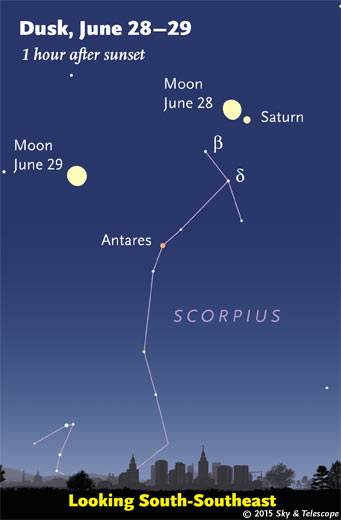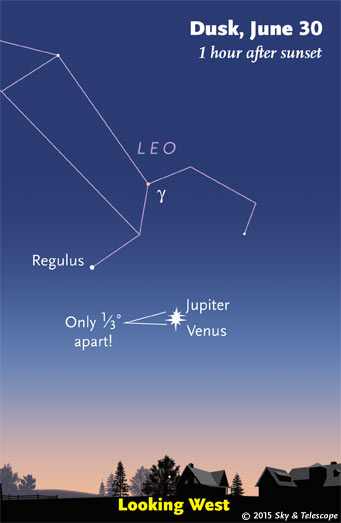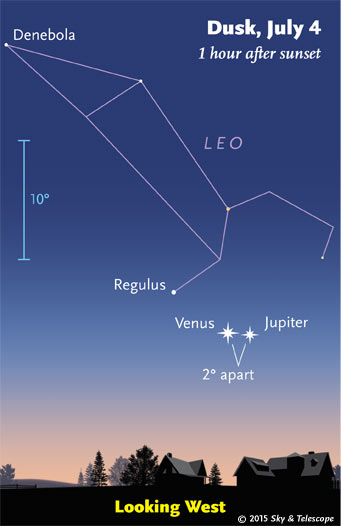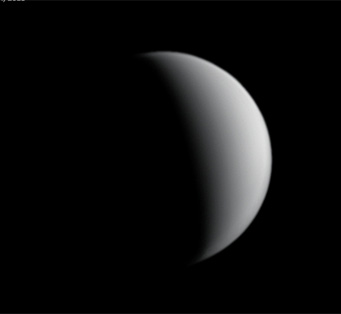Some daily sky sights among the ever-changing Moon, planets, and stars.
Friday, June 26
Venus and Jupiter, shining in the west as twilight fades, are now only 2.2° apart! That's about the width of your thumb held at arm's length. They point to fainter Regulus, twinkling to their upper left.
Watch the two planets move closer together each evening until their appulse (closest approach) on Tuesday the 30th. That evening they'll be just 1/3° apart, seven times closer than they appear now!
In reality, they're not close together at all. Venus is 51 million miles from Earth this evening; Jupiter is eleven times farther at 561 million miles.
Saturday, June 27
Venus and Jupiter have closed to 1.7° from each other in the west at dusk.
In the southern sky this evening, look for Saturn lower left of the gibbous Moon. Scattered to the lower left of Saturn are the stars of Scorpius. The brightest of these is orange Antares.

Sunday, June 28
Saturn shines close to the waxing gibbous Moon this evening. Below and lower left of them runs Scorpius, as shown here.
Telescope users in eastern North America can watch for the thin, invisible dark limb of the Moon to occult the 4.1-magnitude star Theta Librae. Some times: Toronto, 10:58 p.m. EDT; New York, 11:08 p.m. EDT; Miami, 10:48 p.m. EDT; Chicago, 9:36 p.m. CDT; Austin, 9:06 p.m. CDT.
Meanwhile, Venus and Jupiter are now 1.1° apart in the west at dusk (in the longitudes of the Americas).
Monday, June 29
The bright Moon forms a triangle with Saturn to its right and Antares closer to its lower right, as shown here.
Venus and Jupiter are now 0.6° apart in the west at dusk (for the longitudes of the Americas).

Tuesday, June 30
Venus and Jupiter are closest together tonight, 0.3° apart. That's about the width of a chopstick at arm's length. (Depending on the chopstick and the length of your arm, of course.) Jupiter is on top. They'll both fit into a telescope's field of view at low and medium power; Venus is a brilliant fat crescent, Jupiter is a much duller, slightly flattened ball nearly the same size.
In reality, they're very far apart in space. Venus is currently 48 million miles from Earth; Jupiter is a dozen times farther away at 565 million miles, on the other side of the solar system.
Cloudy? They'll remain strikingly close together for days to come.
Wednesday, July 1
Venus and Jupiter have widened to 0.6° apart at dusk in the longitudes of the Americas. Now Jupiter is on the right.
Full Moon (exact at 10:20 p.m. EDT). Look far to the Moon's upper left after dark to spot Altair.
Thursday, July 2
The Venus-Jupiter separation this evening: 1.0°.
This month, spacecraft are imaging the solar system's two brightest dwarf planets, Ceres and Pluto. Find Ceres, magnitude 8.4, just below Capricornus using the chart in the July Sky & Telescope, page 50. Pluto is a daunting 14th magnitude, but its chart starts on page 52. Coincidentally, both are in the late-night southern sky only about 25° apart.
Friday, July 3
Venus and Jupiter are now 1.5° apart low in the west at dusk, widening every day. Jupiter is on the right.

Saturday, July 4
Out to watch fireworks? As dusk settles in, point out to people Venus and Jupiter still forming a striking pair low in the west (1.9° apart), fainter Regulus to their upper left, and the two brightest stars of summer: Arcturus very high toward the southwest, and Vega nearly as high in the east.
__________________________
Want to become a better astronomer? Learn your way around the constellations. They're the key to locating everything fainter and deeper to hunt with binoculars or a telescope.
This is an outdoor nature hobby. For an easy-to-use constellation guide covering the whole evening sky, use the big monthly map in the center of each issue of Sky & Telescope, the essential guide to astronomy.
Once you get a telescope, to put it to good use you'll need a detailed, large-scale sky atlas (set of charts). The standards are the little Pocket Sky Atlas, which shows stars to magnitude 7.6; the larger and deeper Sky Atlas 2000.0 (stars to magnitude 8.5); and once you know your way around, the even larger Uranometria 2000.0 (stars to magnitude 9.75). And read how to use sky charts with a telescope.
You'll also want a good deep-sky guidebook, such as Sue French's Deep-Sky Wonders collection (which includes its own charts), Sky Atlas 2000.0 Companion by Strong and Sinnott, the bigger Night Sky Observer's Guide by Kepple and Sanner, or the beloved if dated Burnham's Celestial Handbook.
Can a computerized telescope replace charts? Not for beginners, I don't think, and not on mounts and tripods that are less than top-quality mechanically (meaning heavy and expensive). As Terence Dickinson and Alan Dyer say in their Backyard Astronomer's Guide, "A full appreciation of the universe cannot come without developing the skills to find things in the sky and understanding how the sky works. This knowledge comes only by spending time under the stars with star maps in hand."
This Week's Planet Roundup
Mercury (about magnitude 0 and brightening) is low in the glow of sunrise. Look for it about 40 minutes before sunrise just above the east-northeast horizon, very far to the lower right of Capella. Binoculars help. To Mercury's right or upper right is 1st-magnitude Aldebaran, farther from it every day.

Venus and Jupiter have their conjunction this week! They're the two bright "stars" close together in the west during and after twilight, shining at an impressive magnitude –4.6 and –1.8, respectively. On Friday June 26th they're 2.2° apart. They appear closest together, just 0.3° apart, on the American evening of Tuesday June 30th. (This is their appulse. Their conjunction in right ascension, which is what's tabulated in many almanacs, is on July 1st.)
By July 4th they've widened to 1.9° apart. All the while, fainter Regulus creeps closer toward them from the upper left.
Mars is hidden deep in the glare of sunrise.
Saturn (magnitude +0.2, in Libra upper right of the head of Scorpius) is highest in the south after dusk. About 13° lower left of Saturn twinkles fiery orange Antares, not quite as bright.
Uranus (magnitude +5.9, in Pisces) and Neptune (magnitude +7.9, in Aquarius) are well up in the east and southeast, respectively, before dawn begins to brighten. Finder charts.

__________________________
All descriptions that relate to your horizon — including the words up, down, right, and left — are written for the world's mid-northern latitudes. Descriptions that also depend on longitude (mainly Moon positions) are for North America.
Eastern Daylight Time (EDT) is Universal Time (UT, UTC, or GMT) minus 4 hours.
__________________________
“This adventure is made possible by generations of searchers strictly adhering to a simple set of rules. Test ideas by experiments and observations. Build on those ideas that pass the test. Reject the ones that fail. Follow the evidence wherever it leads, and question everything. Accept these terms, and the cosmos is yours.”
— Neil deGrasse Tyson, 2014
 2
2








Comments
July 2, 2015 at 4:24 am
wow nice . thanku MacRobert
http://www.skyovnis.com/
You must be logged in to post a comment.
July 3, 2015 at 2:44 pm
This is a wonderful page to carry around. Thanks for explaining and bringing that hravenly sky closer to us. Like that it makes more sense to look up in wonder. Thanks a lot lot lot. Helga
You must be logged in to post a comment.
You must be logged in to post a comment.